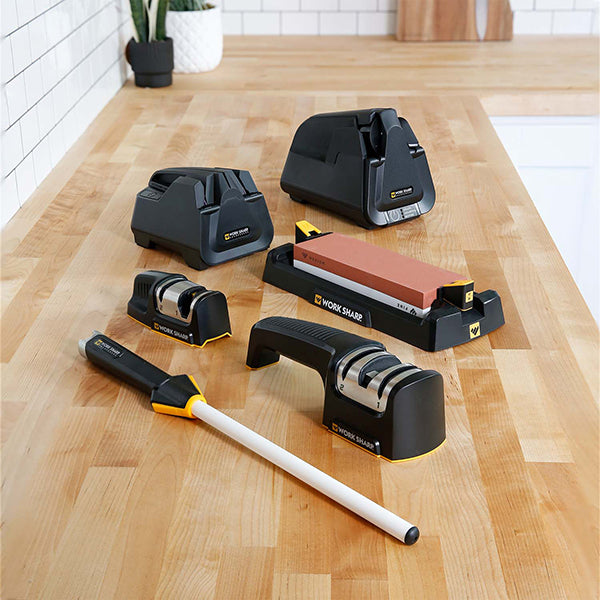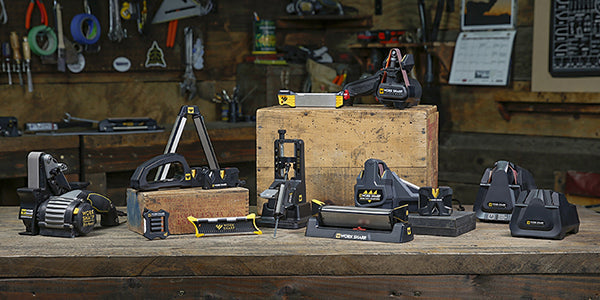Santoku Knife Buying Guide - Work Sharp Culinary has officially become Work Sharp Kitchen. Explore our line of kitchen knives and sharpeners HERE.
(from Cut it Fine, a great online resource for knife reviews and buying guides)

Many people find the entire knife-purchasing experience to be a little bit intimidating. I have found that this is especially true when people are looking into purchasing large knives and unfamiliar knives. It is one thing to go out and purchase a set of steak knives when you have been using steak knives your whole life. It is an entirely different thing to go out and purchase a knife with which you have little or no experience. This is often the situation people find themselves in when they look to purchase a Santoku knife. If you are new to the world of Santoku knives, it is easy to be confused. What type of handle is best? What are those little dimples along the blade’s edge? Why are some taller than others? How do you ensure that this intimating knife will stay together well? Is it even necessary to purchase this knife, or will your array of other kitchen knives meet your needs just fine? The word “santoku” literally means “three virtues.” The name of this knife was chosen to represent its three major uses – slicing, dicing, and chopping. Though the uses of a Santoku knife are very similar to those of a chef’s knife, it is very easy to see that the two differ greatly in their design. What you may not know is that they also differ in their techniques. Though both a Santoku knife and a chef’s knife are created to slice, dice, and chop, the Santoku has many more specific uses than the chef’s knife. In comparison to a chef’s knife, a Santoku knife is more focused on smaller, finer tasks such as creating paper-thin slices of vegetables for garnishes. The different technique one must use with a Santoku knife is a little more difficult to master than that of a chef’s knife, but ultimately leads to finer slices and tinier dices, and takes much less time to complete a task. This guide is designed to assist you in selecting a quality Santoku knife. To create this guide, I spent hours researching Santoku knives and finding out what top chef’s believe constitutes a great Santoku knife, from its tip to its handle. I have also infused a little bit of my own knowledge, based on my own experience with this type of knife, to give you a more down-to-earth understanding of what it is like to work with different types of Santoku knives.
The Importance of Blade Thickness and Cutting Angle
If you read the section above or know anything about Santoku knives, you should be aware that sharp, thin blades are very important in Santoku knives. The blade needs to be sharpened to a very acute angle to ensure that it is able to pierce through the skin of any fruit or vegetable you place it its path, without much fancy finger work on your part. Remember, you want to be able to chop in an up-and-down motion with your Santoku knife. You will not be able to rely on any sort of serrations or the forward and backward motion used with chef’s knives to accomplish your slicing goals. Thin blades are important to achieving thin slices. Whether you want to create extra thin slices of onions for sandwich toppings or paper-thin slices of lunch meat, a thin blade will be necessary. You cannot achieve paper-thin slices with a thick blade. It is also important that your knife has a very sharp cutting angle. Anything over 20 degrees will be much too large of an angle. Try to find a blade with an angle of between 15 and 20 degrees. You are in even better shape if you are able to find a blade which is sharpened to less than 15 degrees. Not all knives are created equal. Do not assume that a knife will be thin and have a sharp angle simply because it is shaped like or called a Santoku knife – do some research before purchasing it. Does the manufacturer list the cutting angle? If not, read some consumer reviews to see how sharp consumers say the knife is. If at all possible, try to find reviews written by chefs and people with no known affiliation to the company in question.
Strength is Important
It is very important that you find a blade which has been constructed with strong steel. Although I suggest strong blades for many knives listed on this page, I believe it is most important for this particular type of knife. Some knives should be flexible (i.e. – a bread knife). A Santoku knife is not one of those knives which should be flexible. Not only will you require a tough, sturdy blade, you will also require a knife which is solidly built. I suggest finding a blade which has been crafted from high-carbon steel or high-carbon stainless steel. The high carbon content in these types of steel offers extra strength. If you feel that you absolutely must choose a stainless steel blade, try to find one which has been fully forged. In other words, try to find one which has been hammered into shape from a large chunk of steel, instead of one which has been stamped from a sheet of steel. The forging process makes any type of steel stronger. In fact, although it is usually more expensive, I suggest selecting forged steel, regardless of the type of steel you choose (be it high-carbon steel, stainless steel, or high-carbon stainless steel). While ceramic knives are quite sharp and do not bend and flex, they are much too brittle for the type of tasks you are likely to complete with this type of knife. If you are a diehard fan of ceramic, I suggest being careful with your choice of cutting board and selecting one which is plastic or wood, since those will be a little easier on your blade than glass or marble would be. The types of techniques one uses with a Santoku knife, though often small, require that the blade and the handle are firmly attached. For this reason, I suggest finding one with a triple-riveted, full-tang blade. If triple-riveted is out of the question, be sure that the knife you select is, at the very least, full tang. The last thing you want is to chop down on something to find that your blade and handle have come apart. This could be a dangerous situation.
A Tall Blade is Helpful
Why do Santoku knives feature such tall blades? There are actually two answers to this question. First, in order to create those paper-thin slices Santoku knives are famous for, you will want your knife’s blade to be almost as tall as (or, preferably, taller than) the food you are slicing. A tall blade will serve as a barrier as you are slicing, keeping your slices even all the way through. Think about it this way – just as you would have a better chance of cutting a straight line through a piece of paper if you cut with the entire length of a pair of scissors, so too would you have a greater chance of creating even slices with a tall-bladed Santoku knife. A blade under two inches tall will likely create uneven slices, much like you would find if you tried to cut through a piece of paper using only the very tips of a pair of scissors. Another advantage to a tall blade is that you can use it for transporting the food you have already cut. By simply turning the blade on its slide and sweeping your processed bits of food onto the blade, you can transport it to a dish or a piece of cookware. Of course, you will want to exercise extreme caution when using your knife in this way, as you open yourself up for more kitchen accidents.
Hollow Edges
You may have noticed that many, if not most, Santoku knives feature dimples along their edges. If you are unfamiliar with this type of blade, take a moment to read this section so that you can understand what these indentations are, how they work, and why they are so important in a Santoku knife. These type of blades are called hollow edge blades, or Granton edge blades. The dimples in these blades create an anti-suction environment which stops food from sticking to the blade. Why is this so important for a Santoku knife? Much of the food you will be working with when using a Santoku knife will be juicy or sticky. From red peppers and onions to chives and garlic, you are likely to encounter many foods which will cling to your blade as you work. Not a big deal, right? You could always slide the food off of the blade with your finger and carry on. Yes, this is true. However, a big reason people choose a Santoku knife over a chef’s knife is because it takes much less time to complete tasks with a Santoku knife. Stopping every five seconds to wipe the blade clean will negate that advantage. Therefore, I strongly suggest purchasing a Santoku knife with a hollow edge.
Want to truly succeed in the kitchen?
With all recipes, we at Work Sharp Culinary recommend starting EVERY recipe with the best tools. To help you succeed, we recommend a sharp knife to prepare your protein. With our newest model, the Electric Kitchen Knife Sharpener, we’ve got the kitchen knife sharpener that’s a perfect gift for your dull knives at a more economical price point. For $59.95, your knives will be accurately sharp at the push of a button. Check it out by clicking HERE.
As an added bonus, we offer newsletter exclusive discount codes, so be sure to sign up if you’d like the opportunity to win knife sharpeners, knives and other kitchen tools!








